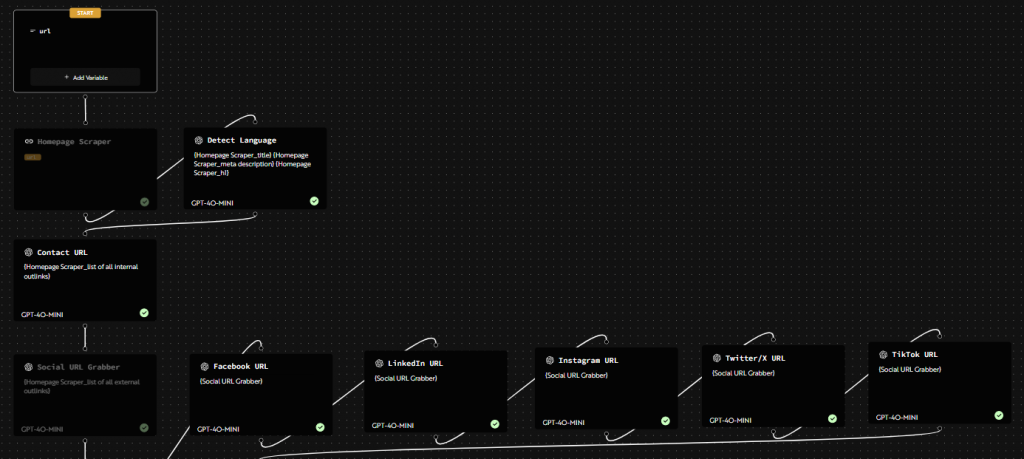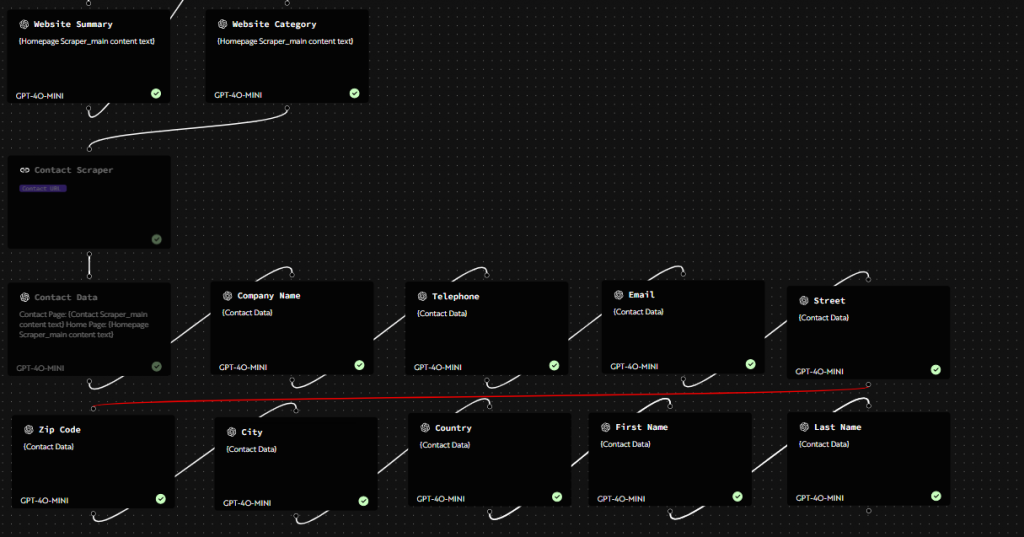Scrape websites for emails and phone numbers, and summarize contact points.
Contact Scraper
Contact Scraper Workflow: Automating the Collection of Website Contact Information
GIBION’s Contact Scraper workflow template offers a comprehensive solution for automatically extracting and organizing contact information from websites. This powerful workflow is designed to navigate through web pages, identify relevant contact details, and compile them into structured data that you can easily use for your business needs.
Rather than spending hours manually searching through websites to find phone numbers, email addresses, physical locations, and social media profiles, this workflow does the heavy lifting for you, allowing you to focus on what matters most – connecting with the right people.
Let’s dive deep into how this workflow operates and transforms unstructured website content into valuable contact information.
How the Contact Scraper Workflow FWorks
The Contact Scraper workflow template consists of multiple interconnected components that work together to extract, process, and organize web data. Each step in the workflow serves a specific purpose in the overall contact information gathering process.

Step 1: Starting with Website Input
The workflow begins with a Local Upload component (Node 0) where you provide the target website URL. This serves as the starting point for the entire scraping process, telling the system which website to analyze and extract information from.
Step 2: Homepage Scraping
Once the target website is identified, the Homepage Scraper (Node 1) goes to work. This component performs a comprehensive analysis of the website’s homepage, extracting several key elements:
- Website title
- Meta description
- Main headings (H1 tags)
- Primary content text
- Internal links (pages within the same domain)
- External links (links to other websites)
This initial scraping provides a foundation of information about the website and maps out its structure, which will be crucial for further data extraction.
Step 3: Language Detection
With the basic website information collected, the Detect Language component (Node 2) analyzes the title, meta description, and H1 headings to determine the primary language of the website. This information helps in appropriate processing of the content and ensures accurate extraction of contact details regardless of the language used.
Step 4: Finding the Contact Page
One of the most important steps in the workflow is identifying the Contact URL (Node 3). This component scans through the internal links gathered in Step 2 to find the most likely contact or “about us” page. It prioritizes pages with keywords like “contact,” “imprint,” or “impressum” (in German websites), which typically contain the richest source of contact information.
Step 5: Social Media Profile Identification
Simultaneously, the Social URL Grabber (Node 4) analyzes the external links to identify and extract links to social media profiles. This component looks for URLs that point to platforms like Facebook, LinkedIn, Instagram, Twitter/X, and TikTok, which can provide additional points of contact and information about the organization.
Step 6: Website Categorization and Summary
To provide context for the contact information, the workflow includes components for Website Summary (Node 5) and Website Category (Node 11). These analyze the website content to generate a concise summary of what the organization does and categorize it with appropriate tags, giving you valuable insights about the entity you’re contacting.
Step 7: Social Media Profile Extraction
The workflow includes dedicated components (Nodes 6-10) for extracting specific social media profile URLs. Each platform has its own extraction node:
- Facebook URL Extractor (Node 6)
- LinkedIn URL Extractor (Node 7)
- Instagram URL Extractor (Node 8)
- Twitter/X URL Extractor (Node 9)
- TikTok URL Extractor (Node 10)
These components filter and clean the social media URLs to ensure you get direct links to the organization’s profiles on each platform.
Step 8: Contact Page Content Extraction
With the contact page identified in Step 4, the Contact Scraper (Node 12) visits this page and extracts all of its content. This typically includes the most valuable contact information, such as phone numbers, email addresses, physical addresses, and sometimes even specific contact persons.
Step 9: Comprehensive Contact Data Compilation
The Contact Data Extraction component (Node 13) serves as an aggregator for all the contact information found throughout the website. It compiles data from both the homepage and the dedicated contact page, with priority given to information from the contact page as it’s typically more accurate and up-to-date.
This component makes intelligent decisions about how to handle multiple instances of the same type of information (like several phone numbers or addresses), generally prioritizing the first or most prominent instance.
Step 10: Specific Contact Detail Extraction
The final stage of the workflow consists of specialized components (Nodes 14-22) that extract and format specific types of contact information:
- Company Name Extractor (Node 14)
- Phone Number Extractor (Node 15)
- Email Extractor (Node 16)
- Address Extractor (Node 17)
- City Extractor (Node 18)
- Country Extractor (Node 19)
- Postal Code Extractor (Node 20)
- First Name Extractor (Node 21)
- Last Name Extractor (Node 22)
Each of these components uses advanced pattern recognition and natural language processing to identify and extract its specific type of contact information from the aggregated data, ensuring accuracy and completeness.

What Makes This Workflow Special
The Contact Scraper workflow stands out for several reasons that make it an invaluable tool for professionals who need to gather contact information efficiently:
Comprehensive Data Collection
Rather than just scraping basic contact details, this workflow gathers a complete profile of an organization, including contact information, social media presence, and context about what the organization does.
Intelligent Processing
The workflow uses advanced AI models like GPT-4o-mini with carefully calibrated settings (such as temperature 0.2) to ensure the extracted information is accurate and properly formatted.
Prioritization and Decision Making
Instead of blindly collecting all available data, the workflow makes intelligent decisions about which information to prioritize when multiple instances are found, mimicking the judgment a human would use when manually gathering contact information.
Language Flexibility
With built-in language detection, the workflow can effectively process websites in various languages, making it versatile for international use.
Structured Output
All extracted information is organized into clearly defined variables, making it easy to export and use the data in your CRM, email marketing tool, or other business systems.
Save Time and Enhance Your Outreach Efforts
The Contact Scraper workflow template represents a significant advancement in automated data collection, allowing you to gather comprehensive contact information from websites with just a few clicks. By eliminating the need for manual extraction, you can save countless hours and focus on what really matters – building meaningful connections with potential clients, partners, or customers.
Whether you’re in sales, marketing, research, or any field that requires reaching out to organizations, this GIBION workflow template can become an essential part of your toolkit, significantly enhancing your efficiency and outreach capabilities.
Ready to streamline your contact information gathering process? Discover the Contact Scraper template on GIBION today and transform how you collect and manage contact information from websites. With GIBION’s intuitive platform, you can easily customize this workflow to fit your specific needs or use it as-is for immediate results.
Related Posts
AI-Generated Product Bundles: Automatic Perfect Combinations
How AI Creates Perfect Product Bundles Automatically In today’s competitive e-commerce landscape, businesses are constantly searching for innovative ways to
Emotional Product Recommendations: How AI Understands Your Mood
How AI-Powered Emotional Product Recommendations Transform Shopping Imagine browsing an online store that seems to know exactly how you’re feeling
AI Shopping Companions: Smart Personal Shopping Advisors
How AI Shopping Companions Are Revolutionizing Retail Experiences In the rapidly evolving digital marketplace, finding exactly what you need can
